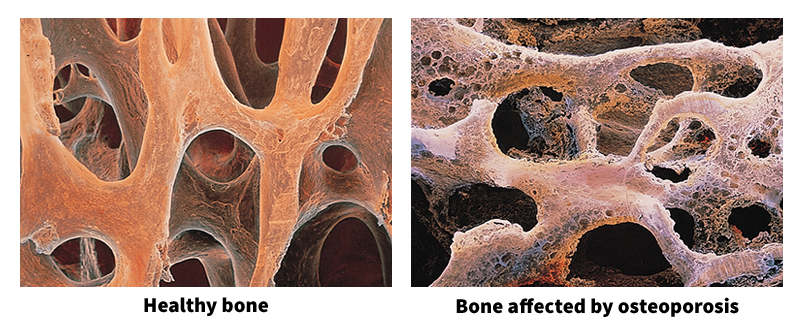Osteoporosis, << `os` tee oh puh ROH sihs, >> is a condition in which bones become abnormally fragile. It is a major cause of pain and disability in older adults. People with osteoporosis have an increased risk of breaking bones throughout their bodies, especially in their wrists, spine, and hips. Breaks may result from minor falls or injuries that would not harm normal bones. Severely affected bones—especially in the spine—may collapse just from the pressure of holding up the body’s own weight.

Causes.
Osteoporosis occurs as a result of bone loss through a lifelong process called remodeling or bone turnover. Remodeling is the chief means by which bones repair themselves. In remodeling, certain bone cells remove worn tissue and other cells form new bone. But the amount of new bone falls short of the amount lost by a tiny fraction. As a result, bone density gradually declines after reaching a peak in early adulthood, when a person finishes growing. In osteoporosis, bone density drops below the level needed to keep bones strong and prevent them from breaking.
Many factors can trigger osteoporosis. Some people form less bone than average, due to heredity or inadequate diet. These people may develop osteoporosis as normal bone loss occurs with age. Other people begin with normal bones but have greater than usual bone loss as they grow older. Factors that can cause excessive bone loss include injury, prolonged lack of exercise, and certain hormonal, inflammatory, and digestive disorders.
One common form of osteoporosis affects women who have passed menopause, the time when menstruation stops. Around menopause, production of the hormone estrogen decreases greatly. Lack of estrogen increases the rate of remodeling, which in turn speeds up the gradual bone loss that accompanies the process.
Prevention and treatment.
People need to consume a well-balanced diet to form and maintain healthy bones. Certain minerals and vitamins, especially calcium and vitamin D, are important for bone health. Doctors recommend that everyone—especially women—eat three or more calcium-rich servings of dairy products each day. People who cannot eat dairy products can take calcium supplements. Regular exercise also helps keep bones strong.
Certain tests use X rays or sound waves to measure bone density. For people with low bone density, several treatments in addition to diet and exercise help limit further bone loss. Some women who have passed menopause can take medication called hormone replacement therapy to supply the body with estrogen or estrogenlike compounds. Scientists have also developed nonhormone drugs that help preserve bone in men and in women who cannot take hormones.
